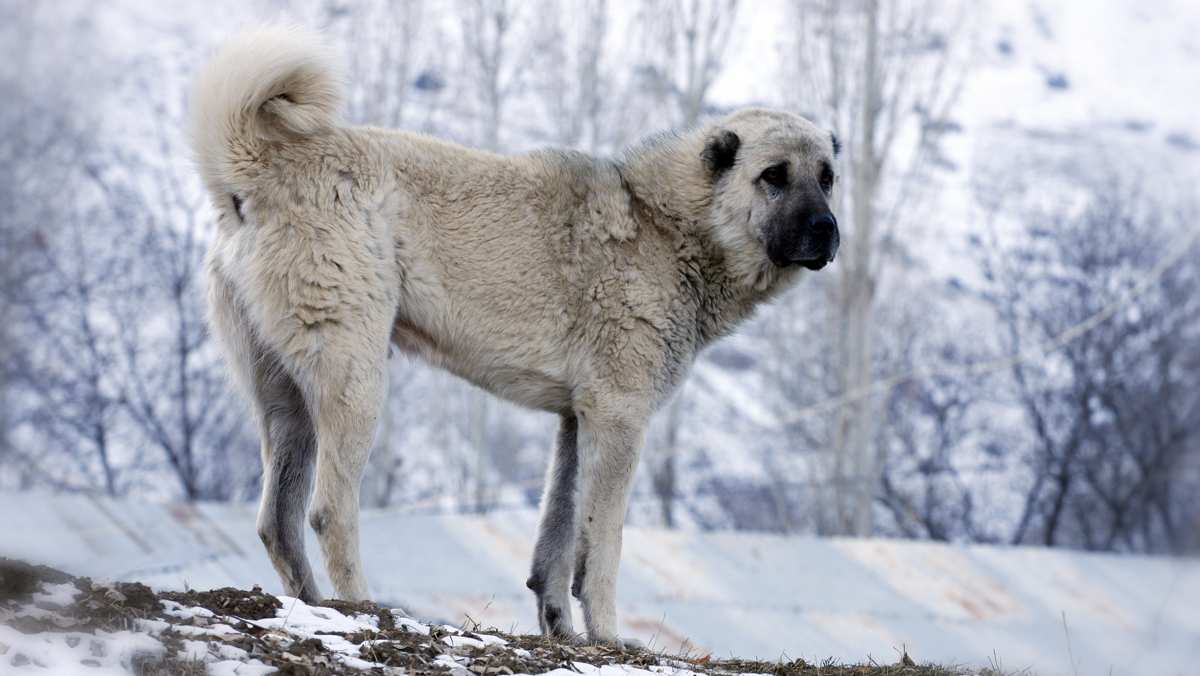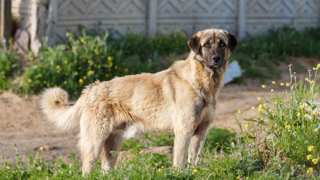The Kangal Dog, known in Turkish as coban Kopekleri, is a mastiff-styled dog that is from the high rolling plains that best describe central Turkey, and in particular from the Sivas Province where it is believed to have originated sometime around the 7th century A.D. (According to a 2005 book by Wageningen Academic Publications titled Animal Production And Natural Resources Utilisation In The Mediterranean Mountain Areas, there is also a theory that a related regional native dog may have been present as far back as 7,000 B.C. and that such dogs were used by the Babylonians, Assyrians and Hittites, among other peoples.) There is Assyrian art from the 800s A.D. that depict the Kangal or a similar dog. Although it is believed to have been first known by the nobility of the time, the Kangal Dog was also known to have been relatively quickly adopted by the region's common people who used them for herding and guarding flocks. Kangals — which are termed livestock guardian dogs — were expected to stave off wolves, lions, bears and tigers.
There is one family that is said to have been long associated with the Kangal Dog: the Aga of Kangal, a large family comprised of landholders and rulers. Although the power of this family has diminished over time, it was for a few centuries — from the 16th until the 19th — that the Aga was one of the more powerful ones.
Ironically, the Kangal Dog is rarely found in homes in Turkey, apparently because much of the country is Muslim and the religion forbids animals to live in the house. (When not herding and guarding livestock, the dogs live in low barns with their charges.) If you want to find a Kangal Dog in its natural habitat, you will most likely have to find a sheep or goat herder. It is because of this relative isolation that the Kangal Dog has remained essentially free of cross-breeding as well as maintained a basic uniformity in its appearance and temperament. The breed is considered by many to be the national dog, and both government and academic institutions have maintained kennels where the the dog's pedigree has been kept largely intact. The Kangal Dog remains a national treasure; no fewer than two Turkish stamps (and at least one Turkish coin) have featured the breed.
Kangal Dogs were not introduced to the United States until 1985, when a couple named David and Judith Nelson imported one after being residents of Turkey. According to the Web site for the Kangal Dog Club of America, David Nelson went on to become the first president of the then-newly established, North Carolina-based club, and Judith "became the first Western observer to report in international canine copyrighted literature the Kangal Dog name and to link this name with its status as an independent Turkish dog breed."
In the following years, the growing recognition of the Kangal Dog — one of the three native Turkish shepherd dog breeds later recognized by the 1996 International Symposium on Turkish Shepherd Dogs (the other two were the Akbash Dog of western Turkey and the Kars Dog of eastern Turkey) — prompted international outreach by symposium members to foreign entities interested in their country's breeds. David Nelson, the president of the Akbash Dog Association of America, Inc. (the ADAA, which he founded in 1978), was one of those who received a correspondence from a symposium attendee and the Dean of Selcuk University, Dr. Tekinsen, regarding the burgeoning controversy regarding Turkish canine breeds. In the letter, the primary argument seems to be that there are three and only three livestock guardian breeds and that the standards are to be set by Turkey and not by any entities elsewhere. (David Nelson also attended the symposium.) This letter, sent to a number of kennel clubs, prompted the United Kennel Club (UKC) to reach out to the ADAA in 1997 for the reason of recognizing the Akbash, which apparently opened the door to also recognizing the Kangal Dog, which the UKC recognized the following year, in 1998.
The Anatolian Shepherd Dog, which is, was and until recently remained at the heart of the controversy, was said to be the same as the Kangal. In USDA studies, Dr. Green addressed the problem directly: "The Kangal is often confused here with the Anatolian Shepherd. There is disagreement on both sides of what constitutes a Kangal or an Anatolian, and the debate has been going on for decades and probably will continue…" It should be noted that Dr. Green also attended the first symposium in 1996. The leading authority on Kangal Dogs appears to be the Faculty of Veterinary Medicine at Selcuk University in Konya, Turkey; a 2005 paper in which it was a primary participant, "Genetic Evidence for the Distinctness of Kangal Dogs," helped to advance this authority. The following year, 2006, the second International Kangal Dog Symposium was held and it was probably no coincidence that the Turkish Kennel Club (TKC) was also founded. By 2015, the TKC had become an associate member with Fédération Cynologique Internationale (CFI) and by December of the same year, the TKC was accepted into the AKC as well.
In recent years, a problem far worse than breed confusion has cropped up: fighting. Unscrupulous breeders have sought to channel the Kangal Dog's static energy (which is reserved for when physically attacked) into unbridled violence. The problem has been addressed formally by both the professional and scientific communities. In 2007, Orphan Yilmaz published the book, Turkish Kangal (Karabash) Shepherd Dog: History, description, breeding. It became a keystone in many subsequent abstracts published by universities and government agencies. In the above-mentioned abstract published by the Canadian Journal of Pure and Applied Sciences, Yilmaz alluded to the problem of exploiting the Kangal Dog for blood sport when he cited his earlier work: "If they are fed on excess meat, their character may be spoiled and they may develop an aggressive attitude." On the Web site for the Kangal Dog Club of America, the problem is addressed directly: "It is possible, of course, to encourage a Kangal Dog to be even more dog aggressive, and to suppress their nurturing behaviors through abuse and neglect." The essay from which this quote is taken goes on, at length, to discuss the ethical ramifications of such behavior.
Although the popularity of the Kangal Dog continues to grow alongside the problems, the clubs responsible for controlling the breeding — along with Turkey, which has apparently taken an active role in restraining the export of the breed — have tackled the problem head-on in a collective effort to prevent the exploitation of Kangal Dogs even as breeders in the U.S. are working to keep the breed as pure as possible.
The American Kennel Club has yet to recognize the Kangal Dog.




